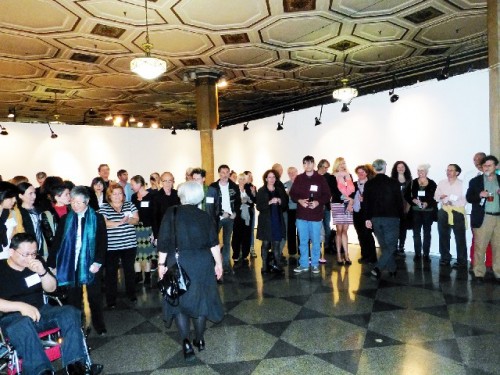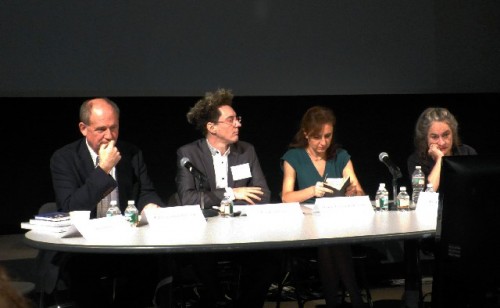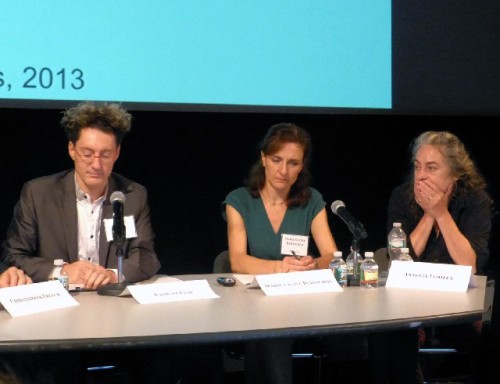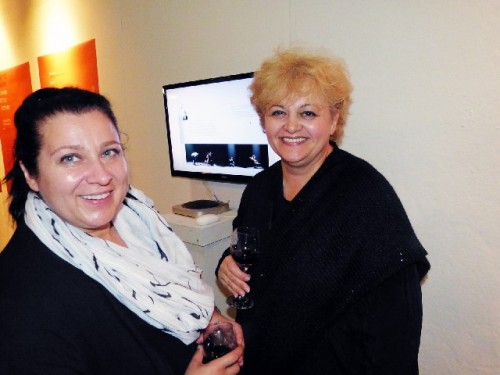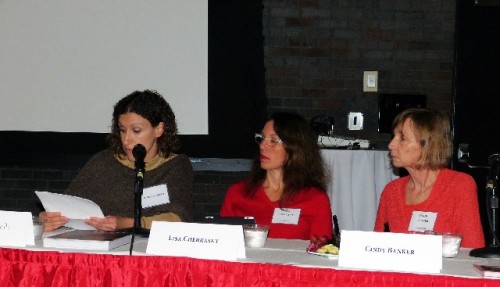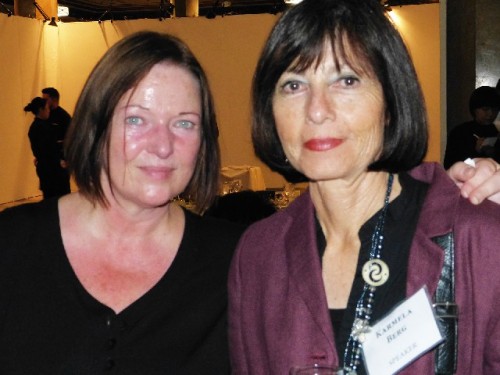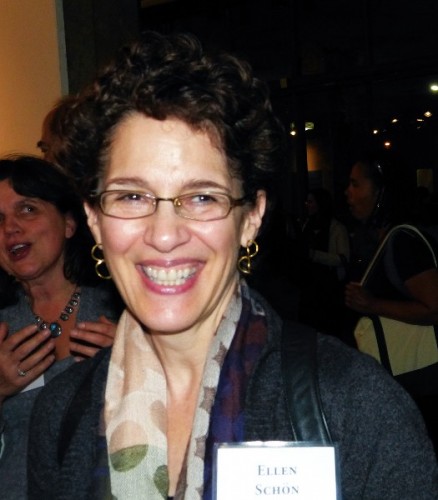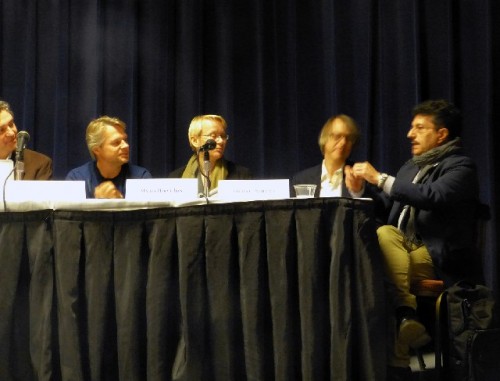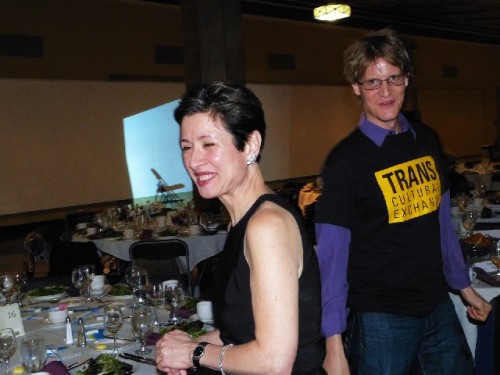TransCultural Exchange Conference 2013
4th Conference in Boston
By: Astrid Hiemer - Oct 20, 2013
International Opportunities in the Arts: Engaging Minds
Mary Sherman, Executive Director, TransCultural Exchange
Lynne Allen, Director, Boston University's College of Fine Arts' School of Visual Arts
400 plus artists, administrators, sponsors and art mavens came together in Boston from October 10-13. They represented 40 countries from around the globe and left after four days energized and full of new ideas and initiatives in the name of ART. The TransCultural Exchange (TCE) conference was hosted by Boston University (BU) as well as other area colleges, universities, museums; the French Cultural Center; and the Taiwan Ministry of Culture supported the conference generously. Also, 16 Taiwanese artists among all explored national and international opportunities in the arts.
Opportunities to participate in US wide and global residencies were introduced at many levels. Some are highly prestigious and competitive; others require formal or less formal applications. Some offer stipends and travel expenses, yet often the ‘European Model’ prevails, where travel costs are a participant’s expense, then food, shelter and some art supplies are on hand. The individual artist becomes a member of a temporary community, works hard in a group setting with outreach to the wider community. An exhibition culminates the experience, where all are invited to the vernissage. In return for the week or more spent at a residency/symposium, artists are asked to donate a work. Those art works often enrich local art museums.
The circle closes; everyone involved has benefited from the experience and so it is no wonder that participants, who have already met residency organizers in Boston will have a leg up, so to speak. In choosing participants, the person and the work will be considered. The goal is to create a harmonious (or not!) creative temporary community. And so sessions were offered in the basics of how to research, apply and find a good fit at a residency program or how to create a new residency venue. Then, there were opportunities for musicians as well as a selection of national programs in contemporary art. Four art associations were introduced: The Alliance for Artists Communities, TransCultural Exchange, Trans Artists and Res Artis.
A grant writing workshop was offered and hands-on introduction to the Research Catalogue: An online Database for Artistic Research; networking, marketing and social media. The Boston Center for the Arts, Boston Architectural College, The Isabella Stewart Gardner Museum, The French Cultural Center, Harvard University, Northeastern University and the Massachusetts Institute of Technology (MIT) all opened their doors for special programs and sessions.
Nearly 40 residencies were introduced by their administrators or sponsors on two different days and in Pecha Kucha succession, so that everyone could experience all presentations. We learned from presenters that reducing their talk to merely three minutes required concise language and visual material and audience members found the presentations quite sufficient. Residencies or symposia were introduced from North to South, East to West Europe; Taiwan, China, South Korea and Japan; Thailand, Vietnam and Nepal; Brazil and Ghana. During the conference there was always time scheduled for individual questions and exchanges after each panel, and here, I’m sure, many connections ensued.
Networking is grand and one conversation may lead to another and assistance to help a project forward, as Barbara Trachtenberg assured me. Dorothea Fleiss, Director of the long standing East-West Artists Symposia recounted how the Fleiss – Giacummo – McAvoy NY Contemporary Art Symposium’s idea was born at the TCE conference in 2011. The NY retreat just ended on Long Island and 12 participating artists from seven countries are showing their work currently at the Islip Art Museum, East Islip, New York until end of December.
The exhibition, ‘Reaching Beyond: New Media Arts in Taiwan,’ was shown at BU’s 808 Gallery during the conference and consisted of several video installations and accompanying texts. A group of US and international artists, Karmela Berg, Alice Grossman, Pirjo Heino, Judith Motzkin and Ellen Schoen are exhibiting ‘EARTH effects’ until October 26 at the Nave Gallery in Somerville, Massachusetts.
Always a popular part of the conference are portfolio reviews and an estimated 300 reviews happened with seasoned professionals giving advice or making suggestions and we learned that a number of artists booked more than one reviewer, in order to elicit different points of view and advice. Clever!
Beyond practical applications, there was time for celebration, of course. Laurie Anderson opened the conference on Thursday with her keynote address, challenging artists to ‘make your own context’ and following are quotes from Sarah Sutro, artist, writer and participant at the conference: “…Anderson is currently an artist in residence at R.P.I. which welcomes artists working on specific projects and is considered a ‘research media place.’ …she willingly gave the audience of artists advice both from her years of multi-media art making and her powerful persona on the world stage of art+media events.”
“She urged artists to ‘have a sense of daring,’ ‘to have a rebellious spirit, not to tow the line,’ and in a twist towards individual exploration, to ‘pick up things and see how they work,’ in the studio, ‘collaborate with your material more.’”
At the end of a two hour long talk she performed and “…read a story from her writings, invited questions and also shared a short piece of music, made with an electric mouth harp – as usual, like nothing we had heard before.”
Michael Dukakis, the former governor of Massachusetts, made opening remarks at a cocktail reception during the next evening. We were thrilled to hear him speak about North Adams in the Berkshires and the Massachusetts Museum of Contemporary Art, short MASS MoCA. He was indeed the first governor, who signed off and allocated millions of dollars to create this vast contemporary art museum in a former factory complex. The next governor intended initially to raze the project and it took 15 years for MoCA to open its doors. The museum, now with a global reputation, has been successful for 13 years, developing or mounting national and international exhibitions, presenting film, dance and performance projects, as well as music festivals. On loan for many years are works in two separate buildings: One is dedicated to Sol LeWitt’s wall drawings and another holds huge works by Anselm Kiefer. The latter exhibitions just opened last month.
A Saturday reception and dinner for participants and invited guests filled the huge space at the 808 Gallery building, which, by the way, people from Boston recognized as a former Cadillac showroom. Again there were many opportunities to make new friends and connections. We met Celia Washington, who is based in London and the founding director of Kathmandu Contemporary Arts Centre. Since 2006 she has dedicated time and fundraising efforts to support Nepalese artists. This was her first time at a TCE conference.
Many introductions and speeches by important Taiwanese representatives were followed by a delightful performance and shadow play by Huang Yi, who first moved in front of a screen with one shadow and then with two shadows on opposing sides. Finally, his shadows solidified into one and disappeared. Definitely a performance artist to watch!
The conference offered many serious and provocative panel discussions and one had to make hard choices:
Our first, ‘International Association of Art Critics (AICA): The Arts as Tools for Life’ was held at MIT’s Bartos Theatre. Present were Raphael Cuir, AICA’s president from Paris, France, Christopher French, president of AICA/USA, Marie-Cecile Burnichon, Secretary General of Platform, a network of collections of the Fonds regioneaux d’art contemporain (FRAC), Annette Lemieux, artist; and Joao Ribas, MIT’s List Visual Art Center’s curator and member of AICA, moderated the panel discussion. It was an illustrious collection of minds.
The art critics were asked from the audience, how artists may get to meet or know them or art critics at large? It took a bit of a commotion to actually connect and exchange ideas with artists in the audience. Panel members had presented serious and theoretical speeches or papers, invoking Marcel Proust, Marcel Duchamp, Andres Serrano, Anish Kapoor, Ad Reinhardt, Joseph Beuys, Francis Bacon, etc., mostly great and not living artists/philosopher.
French showed some of his own work, dispelling the notion that art critics should not be artists as well. Burnichon presented four ‘works of art as tools for life,’ among them Dan Peterman’s ‘Experimental Station, Chicago, The Organic Food Market.’ Critical relief was given by Annette Lemieux, who suggested that it is impossible for her to separate art from life and life from art. She projected her 2012 response to a Philip Guston painting titled ‘Eat, Sleep, 1972,’ which she titled ‘Bad Habits.’ It showed her smoking in bed with a plate of French fries next to her.
There were usually less considered art forms scheduled, such as Food as an Art Form, The Art of Fashion/The Fashion of Art, Sustainability and Re-Cycling as Content, Smell: the Overlooked Sense, The Art of Sound, Social Engagement and others. And, as Sherman writes in her address to the conference:”…The heart of this Conference’s program, though, is our panel sessions. They are organized to encourage artists to conjure up new worlds and avenues of pursuit – to reach out not only to others around the world but also from different walks of life.”
We participated in the ‘Food as an Art Form’ presentation, which looked at food in many different ways. Lisa Cherkasky lives and works in Washington, DC, as a food stylist. She often collaborates with a photographer on food-spreads for magazines or books and considers carefully her and the industries impact on the American obesity epidemic. Chris Muller, Professor and former Dean of Boston University’s School of Hospitality Administration introduced in word and film Claus Meyer, who owns the restaurant NOMA in Copenhagen. It has been awarded the title of best restaurant in the world. Meyer and his staff also grow, produce and collect most of the ingredients on their menu. He declared that: “All Chefs are at their core performance artists.”
Cindy Banker, a Shiatsu practician, faculty member of the New England School of Acupuncture and scholar of classical Chinese medical texts and Chinese herbal medicine lectured succinctly about the thousands of years old history and development of Chinese herbal medicin.
Then Nomeda and Gediminas Urbonas took a very different turn by describing their efforts of returning grazing sheeps and cheese making to the island of Uto (meaning: Outer island) in the Archipelago Sea of the most northern part of the Baltic Sea. These islands, still militarized during the Cold War period by Finland, the USA and Russia, are now abandoned former military outposts. The Urbonas advised the military to return sheeps to the islands in order to clean the biosphere and held a cheese making workshop with members from the sparse population, an almost lost craft.
Dirk Drijbooms is the director of the Apothiki Foundation on Paros Island, one of the Cyclades Islands, Greece. He described his residency on the island as the ‘Art Center for the Living Art and the Art of Living.’ He noted that one positive outcome of the financial and economic crisis still gripping the country is that food production in Greece has much increased, so self reliance has improved.
We attended the panel discussion on ‘Art and Research’s Dissemination and Impact on Contemporary Art and its Creators.’ There were actually three sessions scheduled about art, research and science. The Moderator of this panel, Alexandra Waligorski, represented the Leuphana Arts Program, Germany. Maria Hirvi-Ijas, Finland, is currently working on a book, which is titled: ‘22 Ways on Artistic Thinking.’ She is reflecting on processes and posed the question: Why artistic research?
Gordon Knox, Museum’s Director of ASU – A Museum, of the Arizona State University, presented artistic researchers, who have teamed up with scientists on concrete projects. Christine Lee developed with a scientist particle board without toxic material, including a patent outcome. She also produced particle boards with students. Apparently ASU is now the largest research university in the US, which surprised us.
Michael Schwab is London based and the Editor-in-Chief of the Journal for Artistic Research, JAR, and the Research Catalogue, RC. The journal has an open invitation policy for research paper submission with a peer review panel.
Octavio Zaya is the Director and Editor of Atlantica, which is now an online journal only. He invited guest curators/editors from the podium. Then, he wondered and discussed: To what extend is artistic research different from other research? (Probably not) He was one of several curators of Documenta 11 in 2002, headed by Okwui Enwezor, which in fact was a ‘Reseach Documenta’ based on five different platforms around the globe as well as in Kassel, Germany. Kassel has been the host city of summer long international Documenta exhibitions every five years. Documenta 13 was held in 2012.
Andrei Sicoldi is the director of Kuenstlerhaus Buechsenhausen, Germany, which hosts international Fellows. He presented a research paper and a resulting exhibition at the Kuenstlerhaus.
We added during the discussion that historically it all started with ‘Art and Technology’ at MIT’s Center for Advanced Visual Studies (CAVS) in the 1960’s. ‘Science’ was adopted in the 1970/80’s as introduction to: CAVS, the Center for Art, Science, and Technology.
Our final panel participation was ‘Smell: The Overlooked Sense,’ which was moderated by Chris Busa, Editor of Provincetown Arts Press. Snezana Milanovic, a Harvard University researcher and psychologist presented astounding research results about: Differences in smell between men and woman during moments of fear; females reacted more than males to competitive conditions; women during ovulation could better identify faces; women, who cycle normally have a better smell ability than women, who take contraception. Men and women have identified each other with ‘most liked smells,’ when their gene-set was opposite their own. Diseases produce their own smells; and aging brains function as efficiently as younger ones by using different parts of the brain to identify smells.
Gareth Doherty, a Landscape Architect and Urban Designer believes that smells are not considered enough, when designing environments. He presented a 2009 exhibition by Sissel Tolaas, ‘Talking Nose, Mexico City,’ where she introduced the city’s odors and is developing a vocabulary for various smells. An average person can identify ten thousand odors, while a trained nose can identify a hundred thousand. To smell more and better can be trained!
Jim Drobnick, Editor of the Journal of Curatorial Studies, Toronto, Canada, and Professor at the Ontario College of Art & Design, has researched the history of smell in art. He started his presentation with Leonardo da Vinci’s, 1590 Distillation Apparatus and mentioned among others Bill Viola, ‘Il Vapore, 1975,’ a video installation, where he actually boiled eucalyptus leaves in a pot; and ‘Abstraction = Vaporization, 2002.’ Teresa Margolis filled a room with vapors from water that was used to wash corpses. The water was sterilized, yet created a ‘creep factor.’
Drobnick curated in 2008 an exhibition, ‘Odor Limits’ at the Esther M. Klein Gallery, Monell Science Center, in Philadelphia, Pennsylvania. Among the participating artists were: Oswaldo Macia, who filled trash cans with smells of a community in London: Olive oil, baby powder and mouth wash was among them. Clara Ursitti video-taped a performance collaborating with the Strathclyde Police Department. She was tracked down by a blood hound via her body odor. ‘The Wish Machine,’ installed by Chrysanne Stathacos, released essential oils for $1 from a vending machine. It was a western take on hindu/budhist traditions of applying such oils.
Berkshire Fine Arts reviewed the exhibition: ‘The Art of Scent, 1889-2012,’ curated by Chandler Burr, at the Museum of Arts and Design, in New York City, which closed in March of 2013. Drobnick sees Burr as a writer and curator on the commercial side of scents. We discussed scents/smells/perfumes later with Karen Yates, a stage and sound artist from Chicago, who is interested in combining sound and scent in performance or theatre. She also pointed out that a trend has evolved in the last few years in the perfume industry to create scents or perfumes as uni-scents.
Sherman gives highest honors and recognition to Lynne Allen, the Director of BU’s College of Fine Arts’ School of Visual Arts, who made the conference possible in 2013.
A hard-won art piece could be viewed from Thursday evening to Sunday night, after day light had faded: Florian Dombois and Sherman as curator, with the assistance of others, pulled off a feat that lit up the sky! ‘Public Art Siting: uboc No. 1 & stuVi2’ was a bright blue laser projection between two Boston University buildings, from the George Sherman Union to a student dorm building.
Given current political and policy circumstances, the Boston permit process lasted nearly two years, a saga of its own! And, finally, installing and testing the laser demanded night work, nerves and persistence the day and night before the conference. All efforts paid off and Sherman describes it from her heart after a group, who had photographed the laser beam installation from a helicoper, was traveling on the Mass Pike: “….from I90 (Mass Pike) you drive right underneath it. From there you could see the beam between the buildings as clear as day – the light beam connected them in such a tangible form. It was a fantastic ending to the event. …..The dream happened: At that spot more than 400 people came together, united by the power of art.”
What else is there to say?
Link to additional coverage.

